Get ready to be underwhelmed by my pictures. There are lots of photos of bare twigs, brown soil and unpromising looking shrubs. Twigs they may be but they’re packed with potential – a reminder that next year each will grow and provide what I envisioned when buying them.
Autumn and winter are the perfect time of year to be planting new things in the UK. An interesting thread on twitter reminded me that before the advent of the plastic plant pot, this season was one of the busiest as bare root plants became available to gardeners from nurseries. Dormant perennials, shrubs and trees could be dug up, wrapped in hessian and sent to the grower without fear of the plant being shocked. Once planted, they had a chance to get settled in and could grow away quickly in the spring.
You need a bit of imagination to plant this way – to be able to research what you really need. It’s the opposite of a summer impulse buy. But I love autumn and winter planting – not only are there fewer competing garden jobs to be doing (particularly weeding) but they will need a bit less care and maintenance next year. Certainly they’ll need a bit less watering than a summer planted shrub.
Most of the plants featured here were pot grown, not bare rooted but I can really recommend bare-rooted plants too. For example, if you’re planting a hedge or lots of roses then buying bare rooted is a no-brainer as they will be much cheaper and can be planted right up to March/April with success.
I’m lucky that my soil is workable in all but the wettest conditions of course. I have the previous owner to thank for that – he improved the soil over 40 years with home made compost.
Eucryphia lucida ‘Ballerina’
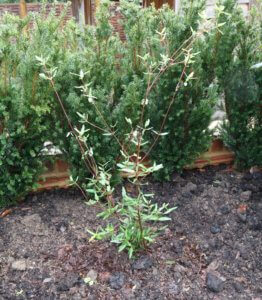
The prospect of this plant doing well in my garden makes me want to do cartwheels. It came mail-order from Burncoose Nurseries in Cornwall, who stock a huge range of interesting rarer plants and are adept at mail-order, with fast delivery and expert packaging. I was delighted to see this plant on their stock list as I had seen a splendid specimen of a similar variety called ‘Carousel’ in a friend’s garden last summer.
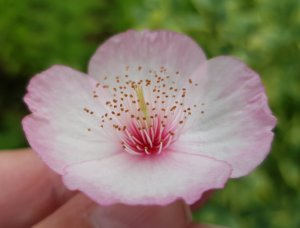
Eucryphia lucida ‘Carousel’ – flowering last June in a friend’s garden
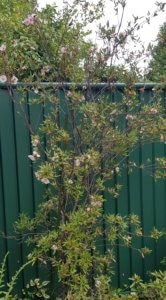
Eucryphia lucida ‘Carousel’ – flowering last June in a friend’s garden
Looking at my small plant now it’s hard to believe that it will one day carry such intricate flowers. They are the shape of a cup-cake case and have incredibly long stamens. The blush pink fringing and magenta centre take its beauty to another extreme.
This Eucryphia is planted in my new tropical border area in a prime position. I wouldn’t say it has a classic tropical look but it’s such a stunner I felt it deserved a prominent position near the patio. The Burncoose care guide says it thrives when you can create a little “cloud forest” microclimate, surrounding it with other plants and shrubs. Here it is sheltered, the roots can be shaded and kept cool but it has its head in full sun. I’m optimistic it will be happy.
Pineapple Broom – Argyrocytisus battandieri
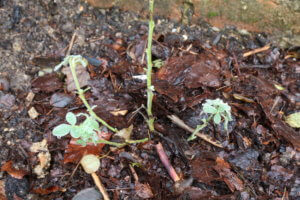
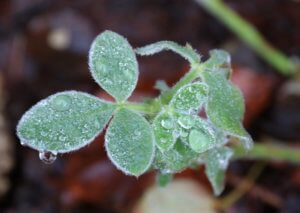
Here’s another new shrub for my tropical area – a plant that looks exotic but should be hardy enough here. I don’t recall ever having seen one in real life but I saw some images in a book and wanted one.
It’s just as well the picture I saw was of a lovely mature one. I’m not sure many people would have picked this off a garden centre bench without prior knowledge. To see some pictures of the glory that awaits you can see some pictures of mature Pineapple Brooms by clicking here. The flowers look a bit like stubby lupins and are a glorious pineapple yellow in colour.
New hydrangeas
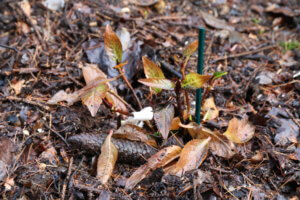
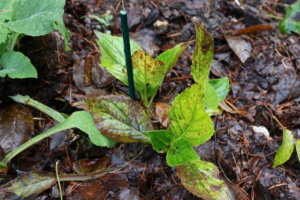
Autumn and winter are great times to plant dormant hydrangeas. They are pretty thirsty plants until well established and so summer plantings keep you busy with the watering can.
I have just planted two new hydrangeas to the side of the entrance to my woodland area. Both are white lacecap varieties – one called ‘Fireworks’, with showy star-shaped florets at the extremities, the second called ‘Love You Kiss’ with blushed white florets.
They are small for now but I’m hoping they’ll grow well over the next few years.
I was never a huge fan of hydrangeas but during a visit to the Savill garden near Windsor two summers ago I stumbled across a semi shaded area planted with numerous different interesting varieties – mopheads, paniculatas and lace-caps. The way the paler white and pink blushed types shined in the shade piqued my interest and I’m happy to be giving some a go in my garden.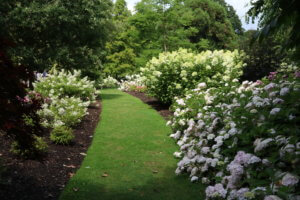
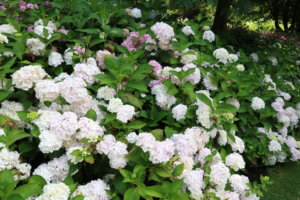
Hazel – corylus avellana
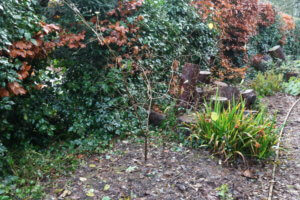 I needed a plant to help to create a better gateway to the woodland walk (pictured at the top of this diary article) and having blown my budget on the new shrubs above, I decided to go for more hazels. There are numerous hazels in this woodland area, some self seeded, presumably from nuts buried by squirrels.
I needed a plant to help to create a better gateway to the woodland walk (pictured at the top of this diary article) and having blown my budget on the new shrubs above, I decided to go for more hazels. There are numerous hazels in this woodland area, some self seeded, presumably from nuts buried by squirrels.
I dug up two self-seeded saplings, and planted them alongside the log pile. The roots came away with very little soil attached – my own bare-root saplings. This is just the sort of job I would not do in the summer as I would forget to give it the water it would need in hot weather. Over time I will coppice these plants so that they look like the multi-stemmed hazels elsewhere in the woodland area.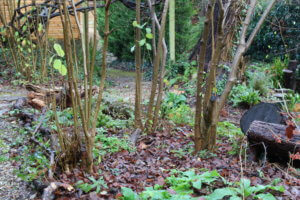
Rambler Rose – ‘Bobbie James’
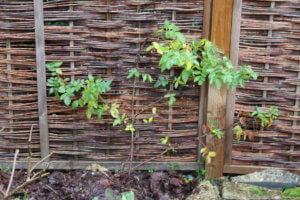
Autumn and winter are definitely the best times to plant roses and buying them bare-rooted will always save you money. Moving roses is also a better idea in the dormant phase than in summer.
This rambler was moved from another part of the garden. It was only planted two years ago but unfortunately it was planted alongside a garden wall which then started to fall down. I couldn’t afford the brickwork for a new wall so it was knocked down and I planted a hedge instead. Bobbie James is described by David Austin Roses as being a “giant climber’ and so needed relocating as it would have suffocated the new hedge.
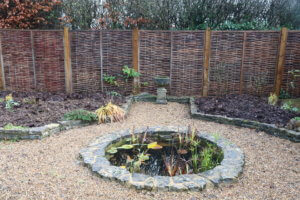
Bobbie was dug up, and planted alongside this very bare fence in the pond garden. Here he can run riot for a while although he’ll need a bit of taming in the long run.
Styrax japonica ‘Pink Chimes’ – Japanese Snowbell Tree
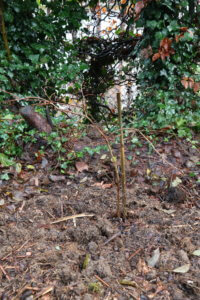
I’ve saved the least impressive set of twigs til last. This is exactly the kind of plant a member of my family might trample on by accident. It barely looks like a specimen at all.
This ugly duckling will, one day, become a beautiful swan of a tree. It’ll take a few years but it should do well in this semi-shaded woodland area, where its pink bell shaped flowers will dangle from the branches and provide yet more interest for my woodland walk.
This seasonal diary is part of a weekly link-up of garden bloggers from around the world, called Six on Saturday. For more information and links to other blogs crammed with gardening activity, check the blog of host The Propagator.
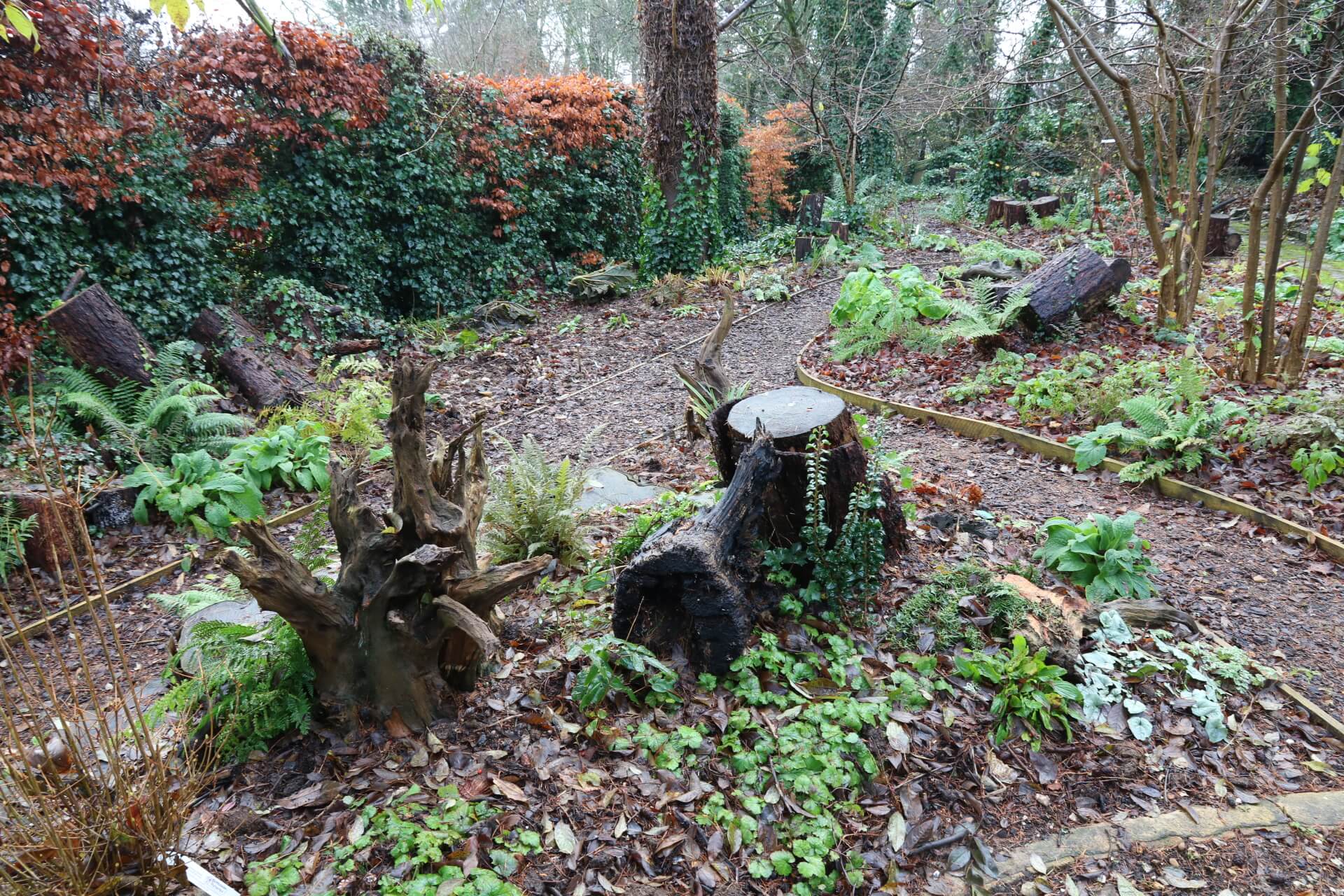
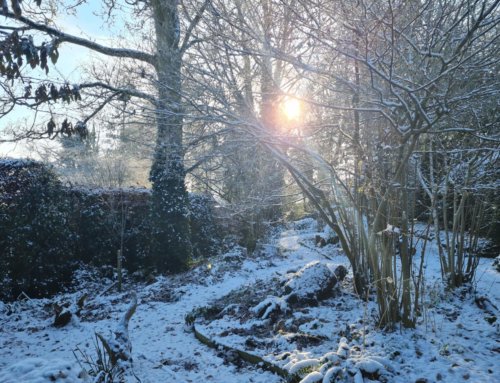
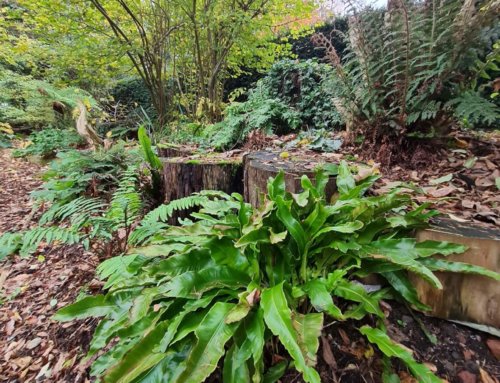
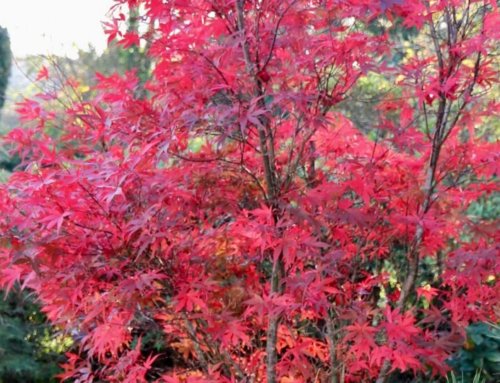
You will certainly be rewarded for your efforts in the spring and summer. I planted my bare root roses on a very cold day and am worried I didn’t plant them deep enough as was so keen to get back indoors. I have been toying with the idea of hydrangeas as I am a fan of their blousy blooms but not sure whether they will thrive on our chalky soil.
I’m not sure about hydrangeas on chalk. I did see a fabulous one for a pot when I was researching these. It’s a white one called ‘Runaway Bride’ and was RHS Chelsea Flower of the Year in 2018. It has a fabulous shape and flower form. It wasn’t cheap but it looked to me like it would be a real impact plant on a patio.
A beautiful selection and much for the coming seasons.
Thanks Paddy – lots to look forward to.
Such a lot of potential in those bare twigs. I hope they do very well for you. I did laugh at the comment about the twig that a family member might trample on by accident. I think I’ve done that to a few things I’ve planted.
Hi Hortus – yes me too. That’s why I’ve left the bamboo cane next to the styrax for now. It may need a stake eventually but it’s not big enough yet. The cane will remind me that there’s something precious there!
What great taste you have! All fabulous plants. I love the pink eucryphia and and the styrax especially!
Hi Gill, thanks so much for your kind comment. I have to admit that my taste is fully influenced by things I see on garden visits, things my friends grow and things in books and the internet. I have a mental list of things I’d like and when I see them on a stock list or garden centre shelf I pounce. I’m not a big shopper when it comes to clothes etc but if it’s a plant I don’t hesitate.
I had been hesitant to buy a styrax and plant it but it needs a dedicated place because it’s a shrub/tree that needs space, it seems.
Likewise, I’m still in love with the cornus controversa variegata and this one also needs a good location ( that I don’ have yet)
Nice choice of shrubs and I’m looking forward to seeing them grow up
Your comment had me so worried Fred as I hadn’t really thought fully about how big the Styrax might grow! I even popped out in the rain yesterday to have a look. It doesn’t have a wide open position but I think it does have enough space and if it grows well will be a real focal point in this woodland garden area. I may need to prune it a bit to encourage it to fill the space it has well. I agree that the cornus controversa absolutely needs a full open position. I have one (not variegata) in the lawn by my driveway and it has no competition at all. It really is spreading and is shaping up beautifully.
Phew, so much the better if you have space for it! I didn’t want to upset you because I don’t realize the space you have but it was more like a kind of complaint not to be able to have one for me …
Please don’t worry about upsetting me now or in the future. We’re all here to learn and share. I honestly was so excited about the look of the styrax flowers that I hadn’t researched enough the full size of a mature tree! It’s rare for me to overlook such a thing but I got carried away. Its site is OK but it’s still a bit tight. I will need to shape it carefully so that it grows up a bit before spreading as there’s a path nearby. We’ll see!
I’m looking forward to seeing Eucryphia lucida ‘Ballerina’ do its thing in due course. Exciting.
I hope it flowers Graeme. I was so entranced with my friend’s plant. She’s got a great eye for shrubs and has so many amazing things in her garden.
That is a great way of buying plants, I have decided to stop growing plants for visiting friends in pots, and just give them bare root, or just dug up plants there and then. I think the plants grow on much better, than after having spent weeks in pots, plus I don’t need to water them, and they are less likely too to lurk in the pot in their garden and be forgotten. I have had good feed back on growing on success too. Looking forward to admiring your shrubs and trees in due course.
I so agree with you Noelle. I have a friend who often turns up with something she’s dug up and plonked in a sack. They always grow away so well, like they’ve not even noticed they’ve been moved!
Very interesting Six-on-Saturday. Apart from a hydrangea, I don’t have, nor have I ever grown, any of your plants. I do like that eucryphia.
Hi Granny, that’s what I love about sharing blogs like this – I often get to see things others are growing and take away new ideas. The Eucryphia really is stunning in flower. I just hope I can get it to flower in my garden.
Wow you have been busy, how exciting it will be to see that lot grow.
Thanks Sel – I’m sure to feature all of these in the future as they do their stuff.
I’ve had a couple of Eucryphias for some years but neither has yet flowered. I moved one (milliganii) out of its shady location into the open a couple of weeks ago. As you say, it’s the best time to move and plant things, they barely notice. The least impressive set of twigs is far from that for anyone who knows the plant. I would love a Styrax, any Styrax, but really don’t have room.
I was very excited about the styrax but I did laugh when I unpacked the twigs. I may have to wait for it to do its stuff but as you say – it’ll be worth the wait. I hope it likes where I’ve planted it. I was slightly worried that it doesn’t have enough space, especially as both you and Fred have commented on this. I popped down to have a look and I think will be fine. The Burncoose care guide says it can be pruned after flowering to restrict its size if necessary. We’ll have to see!
Isn’t it amazing how quickly you forget about how things used to be done! Plastic pots can save the day! I do not know the Eucryphia, and I was admiring the flower! It is lovely. The pineapple broom is also new to me, and I do love its silvery edged leaflets and the promise of those wonderful flowers. You have some wonderful plants to look forward to!
There’s a huge debate raging in the UK about the use of peat in composts. The use of plastic pots in the horticultural industry has added to the scale in use of composts and therefore peat extraction. If we went back to bare root planting for some things it would really help. Peat free composts are more freely available but are rarely used in large commercial operations.
I was converted to Fatsia this year after lockdown walks in the Botanic Gardens. Love it!
So much to look forward to. I used to work in a garden with a Styrax, It’s such a beautiful plant.